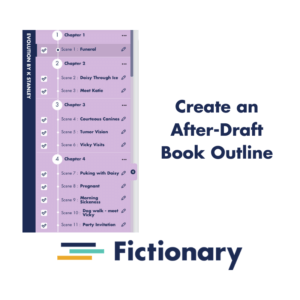
Book Editing for Writers and Editors
A book outline is important for every novelist. Today, we’re talking about an outline that you create after you’ve written a draft and how that outline is going to help you edit your story.
An outline of your novel is the name of every scene written in as few words as possible and listed in sequence. The name of the scene should be specific enough that when you read it, you know what the scene is about.
It doesn’t matter if you’re a panster or a plotter. It doesn’t matter how you achieved writing your first draft. What matters is how you’re going to effectively edit your story to make it into something powerful.
We believe story editing begins with editing at the scene level because a powerful story is made up of powerful scenes.
If you’re an editor, you’ll need to create the after-draft outline to ensure you’re giving the most comprehensive edit possible.
The Easiest Way to Create an After-Draft Outline
Naming each scene in your story in three words or less will create an after-draft outline AND help you edit your story.
The scene name should represent the main theme or main action of the scene. It should be something you can read and immediately know what happens in the scene.
Benefits of an after-draft book outline
1. Know what the scene is about
This may seem obvious, but in the excitement of writing a first draft, it’s easy to get carried away. Your characters take over. Your imagination explodes. Whatever the reason, it’s important to review each scene.
Creating a scene name helps you determine the purpose of the scene.If you can’t name a scene, the scene may be unfocussed, not have a goal, or not be related to the plot. Naming a scene is the first step in knowing if there are problems in the scene.
At this point, you may want to re-evaluate the purpose of the scene in case you’ve changed your mind from when you first wrote it.
2. Keep track of scenes when you move them around
Naming the scene will create an outline you can reference as you edit. You can scan the left panel in StoryTeller when you’re looking for a scene.
As you work through the character, plot, and setting story elements, and then review the visual insights (whether in StoryTeller or you drew a story arc by hand, you may find you need to move scenes around.
3. Evaluate tension using the book outline
A list of scene names is also helpful when you’re evaluating the structure of the novel. You can scan the list and analyze if the scenes appear in the best order to create tension.
For those of you who like to learn visually, get into more depth in this video.
Jerry Jenkins has a helpful post on how to create an outline before you start writing your story.
![]()
StoryTeller is creative editing software for fiction writers. Transform your story, not just your words. Successful stories depend on your ability to edit, improve, and revise your work. Only when you master story editing, can you master storytelling.
Why not check out Fictionary’s StoryTeller free 7-day trialand tell powerful stories?


